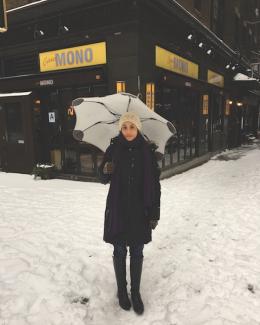Growing up, all of Jocelyn Ross’s experiences with cities were as a tourist. San Francisco was the first city she ever lived in: “I was raised in decidedly non-urban east central Illinois,” she explains. “I don’t remember even hearing the term ’urbanism’ before moving here.” Ross, who worked until recently as a machine learning engineer for payments startup Stripe, has been living in the Bay Area for the last fifteen years, San Francisco for five. She got her start in tech at Facebook back in 2006, where she started and grew the risk management team after graduating from Stanford. Today, you’ll find her studying languages, writing, cooking with lots of vegetables and reading everything, especially science fiction and fantasy. She may have come late to urbanism but now she’s a full-fledged flaneur: “Walking is easily my favorite mode of transportation and has been a great way to experience the city."
How did you first get interested in cities and how did you first learn about SPUR?
My husband and I made the move to San Francisco from the peninsula a little over five years ago when the company I was working for relocated to the city. As I made the adjustment from a driving-in-the-suburbs mindset to realizing that I can walk and take public transit to get to a stunning variety of things happening at any given time, I became more and more interested in how San Francisco developed as a city. I started going on walking tours of different neighborhoods, reading books about the city and learning more about its history of the land. I wanted to figure out how I could get involved.
I first heard about SPUR through the Voter Guide, which was so necessary in helping me understand the propositions on [last year’s] very crowded ballot. In the last six months, I’ve begun attending more of the panels and events at SPUR to learn about and engage with different aspects of our city. I’m especially interested in how the different methods of transportation work (or don’t work) together as a system, why our roads and routes look the way they do now and what the impacts of changing them might be. Learning more has also helped me expand my mindset and interest from San Francisco itself to the region as a whole and how we relate to the state and nation.
What is your favorite urban view?
The view from the top of Twin Peaks looking out over the Bay just as the sun is starting to set can’t be beat. I was part of a running group that would schedule runs up Twin Peaks to get there just in time for this view — the sunset provided a great excuse to sit and rest a while, too.
Favorite city?
Apart from San Francisco, which has an unfair advantage since I live here, my favorite city to visit is New York. I love how easy it is to get around and how much there is to do — museums, restaurants, historical neighborhoods, shows, endless walks in different parks. There are always new streets and stores to explore and an amazing diversity of people that help give the city its distinct character.
Favorite book, film or work of art about cities?
The Ghost Map: The Story of London’s Most Terrifying Epidemic — and How It Changed Science, Cities and the Modern World by Steven Johnson was the first book that got me thinking about the impact of cities on health. The author shows how European urbanization led to a cholera outbreak in London in the 1850s. He then uses the lessons from it to examine how cities, ideas and science change. I would recommend it to anyone interested in science, history, public health, marketing, design, terrorism, cities or books where one of the main characters is named John Snow. For fiction, N.K. Jemisin’s short story “The City Born Great” is a must-read for a completely new take on the lifecycle and personalities of urban areas.

